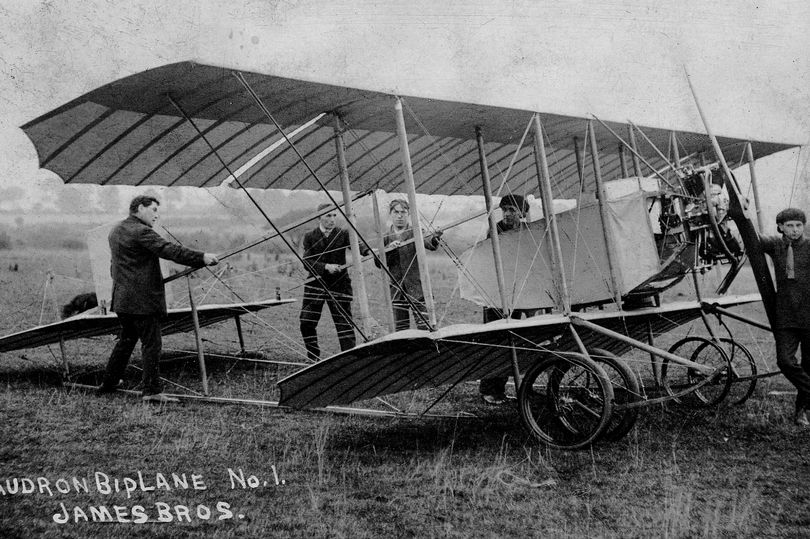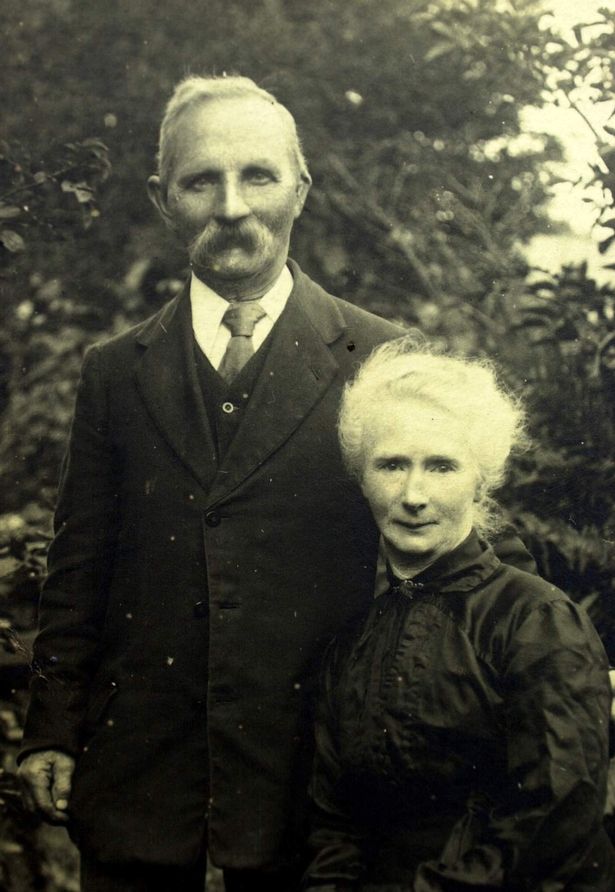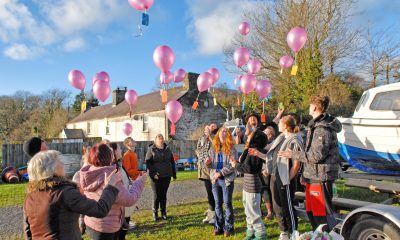Community
Did the world’s first airplane fly in Pembrokeshire?

WHEN asked who was the first to fly an airplane, you’d probably say Wilbur and Orville Wright, more commonly referred to as the Wright brothers. However, you’ve probably never heard of Bill Frost, a Welshman who many say was the “first man to fly.”
Born in Saundersfoot on May 28th, 1848, Bill Frost was a carpenter on the Heyn Castle Estate.
Clearly, as a handyman, he was in the perfect position to build a plane, and this obsession, if the tale is to be believed, was strengthened in the winter of 1876. Legend says that Frost was carrying a large plank of wood on a windy day when a large gust of wind picked him up, carried him several feet, until he returned to the ground with a rather rough landing.
What followed was, shall we say, some rather odd behaviour.
Locals reported seeing Frost running around fields, with a large sheet of zinc above his head, presumably trying to get another gust of wind to lift him up. Although he was testing the limits of aerodynamic designs in all likelihood, he was of course branded rather bizarre locally.
Many locals also attributed this behaviour to grief, as his wife and daughter had recently died. A religious man and deacon of his local chapel, one could understand locals believing he was maybe trying to get to Heaven.
In 1894, things started to get serious for Frost, who applied for a patent for a flying machine on October 25th. To describe the patent would be to describe an amalgamation between a plane and a glider, with two reversible fans which would, he hoped, lift him into the air for a successful flight.

Bill Frost with his wife, Annie, in 1896 . Bill lived until 1935.
Then, the patent said, wings would be spread via a lever and another lever would control whether the aircraft was moving up or downwards.
With his practical knowledge and his interesting research methods, Frost began work on building the aircraft.
He did so in the workshop of his house on St Bride’s Hill, an impressive feat when you consider it was over 30 feet long.
Reports state that the aircraft was built out of bamboo, canvas and wire, with bags and pouches filled with hydrogen to help it stay afloat.
The patent, in full, reads: “The flying machine is constructed with an upper and lower chamber of wire work, covered with light waterproof material. Each chamber formed sharp at both ends with parallel sides. The upper large chamber to contain sufficient gas to lift the machine. In the centre of upper chamber a cylinder is fixed in which a horizontal fan is driven by means of a shaft and bevelled gearing worked from the lower chamber. When the machine has been risen to a sufficient height, then the fan is stopped and the upper chamber, which has wings attached, is tilted forward causing the machine to move as a bird, onward and downward. When low enough it is again tilted in an opposite direction which causes it to soar onward and upward, when it is again assisted if necessary by the fan. The steering is done by a rudder at both ends.”

A book has been written about the subject
So, why are the Wright brothers considered the first men to fly?
Well, for starters, there’s no photographs of Frost’s flight, nor any written testimonials. However Frost himself, as well as several locals in the area, claimed that on September 24th, 1896, Frost flew for approximately 500 yards.
This, if true, would have been a considerably longer flight than the Wright brothers achieved.
The end of the flight was not so successful, however, as the bottom of the craft hit a tree and crashed into a nearby field.
Not deterred by this, Frost repaired the machine, however it was then destroyed in a storm some weeks later, and Frost could not afford to build a new one from scratch.
His patent expired four years later.
Without a craft for another flight, and with no photographic evidence, his claim to be the first man to fly, unfortunately, can not be verified.
In 1935 Frost died aged 90 years old. Although he held no grudge against the Wright brothers, he did state that the government had turned down his application for funding following his first attempt, which scuppered the hope of any future flights after his craft was destroyed.
The reason for this? The government claimed that aircraft would never be used for navigation or warfare; a statement that looked very foolish as World War I began to play out.
HTV footage from the 1990’s on the Bill Frost story (Youtube)
Community
Future of Milford Haven Library set to be secured by agreement

A CALL to residents for a potential £3.35 annual contribution to help support a town library has been overwhelmingly supported, councillors heard.
In a submitted question to Cabinet Member for Residents’ Services Cllr Rhys Sinnett, heard at the December meeting of Pembrokeshire County Council, fellow Milford Haven councillor Cllr Alan Dennison asked: “I and many residents of Milford are deeply concerned about the drastic cut in funding for the Milford library, which has hindered its ability to function effectively, especially given its lack of a permanent location since its sale years ago.
“Many residents have voiced their dissatisfaction with the request for over £3 weekly contributions to keep the library operational for another year, particularly while we see ongoing financial support for Haverfordwest.
“As a councillor for Milford and responsible cabinet member, you are aware of the PCC’s plans for the Haverfordwest library.
“Are you not concerned, as your constituents are, about the insufficient investment in our town’s library, especially in light of the seemingly unlimited funds directed towards Haverfordwest and can you identify what plans are in place to support Milford library going forward?”
Cllr Sinnett responded by saying the county council was working in partnership with the town council and Milford Haven Port Authority to consider options to improve the financial sustainability of the library.
Milford Haven’s library has been based at the town’s Cedar Court for the past 16 years, with its lease running up to 2034, members heard.
He said the cost referred to were a town council survey of residents to see if they were willing to contribute, through the town council part of the overall council tax bill, towards the library, at a cost of £3.35 per year, with more than 89 per cent of responses favourable.
He said Haverfordwest was “not immune” from any potential cuts and cost savings, but funding had been secured to address antisocial behaviour at that library.
Charity
Welsh opticians raise £1,600 for people experiencing homelessness

SPECSAVERS Pembroke Dock has helped raise £1,600 to support people experiencing homelessness this winter, with all funds going to The Wallich’s winter appeal.
Thirteen stores from North, South and West Wales donated £1 for every customer feedback form completed during November to help The Wallich, Wales’ largest homelessness and rough sleeping charity, continue its vital work.
Supporting more than 8,000 people experiencing or at risk of homelessness across the nation each year, The Wallich runs around 100 diverse projects across 20 local authorities to provide hope, support and solutions to end homelessness.
Funds raised by Specsavers will go directly to the Wallich’s Flexible Assistance Fund, which provides small but vital emergency grants. The grants support people at crucial turning points, helping cover essential costs such as phone credit, rent or food shops.
This initiative is a continuation of Specsavers’ wider homelessness programme, which sees over a hundred Specsavers stores and Home Visits services hold out-of-hours or pop-up clinics and invite people affected by forms of homelessness to use their services for free.
Specsavers’ North Wales regional relationship manager, Martin Lawrence, who helped organise the fundraiser, says: ‘We’re really proud to be supporting The Wallich’s winter appeal at a time when support is needed most.
‘Homelessness affects people in every community and as locally owned and run businesses, Specsavers stores are committed to raising awareness of the issue and supporting people through their toughest moments.
‘We’re excited to build on the success of this fundraiser and strengthen our partnership with The Wallich in the new year.’
Louisa Turner, head of fundraising at The Wallich, adds: ‘Winter can be an incredibly difficult time for people experiencing homelessness and this support from Specsavers will make a real difference.
‘The funds raised will help provide emergency grants at critical moments – whether that’s putting food on the table, helping someone stay connected with their loved ones or preventing someone from losing a safe place to live.
‘This kind of support creates vital turning points and helps people move towards a safer, more secure future.’
Specsavers works year-round with homelessness charities including Crisis, Vision Care and The Big Issue, to improve access to healthcare and advocate for policy change – ensuring people experiencing homelessness can receive free eye tests, glasses and hearing checks.
To find out more about Specsavers or to book an appointment at your local store, visit: https://www.specsavers.co.uk/stores.
Business
Community council objections to Tenby Lidl store scheme

PLANS for a new store on the edge of Tenby by retail giant Lidl, which has seen objections from the local community council, are likely to be heard next year.
In an application recently lodged with Pembrokeshire County Council back in October, Lidl GB Ltd, through agent CarneySweeney, seeks permission for a new 1,969sqm store on land at Park House Court, Narberth Road, New Hedges/Tenby, to the north of the Park Court Nursing Home.
The proposals for the latest specification Lidl store, which includes 103 parking spaces, would create 40 jobs, the applicants say.
The application follows draft proposals submitted in 2024 and public consultations on the scheme, with a leaflet drop delivered to 8,605 local properties; an information website, with online feedback form; and a public exhibition, held last December at the De Valence Pavillion in Tenby, with a follow-up community event held at New Hedges Village Hall, close to the site, publicised through an additional postcard issued to 2,060 properties.

Some 1,365 responses have been received, with 89 per cent of respondents expressing support for the proposals, the applicants say.
A supporting statement says: “Lidl is now exceptionally well established in the UK with the Company operating c.980 stores from sites and premises both within and outside town centres. Its market share continues to increase substantially, and the company is expanding its store network considerably. The UK operational model is based firmly on the success of Lidl’s operations abroad with more than 10,800 stores trading across Europe.
It adds: “The granting of planning permission for the erection of a new Lidl food store would increase the retail offer and boost the local economy. The new Lidl food store would create up to 40 employment opportunities for people of all ages and backgrounds, providing opportunities for training and career development. This in turn will create an upward spiral of economic benefits.”
Local community council St Mary Out Liberty Community Council has formally objected to the scheme, saying that, while it supports the scheme for a Lidl store in principle, recognising “the economic benefits a new retail store could bring,” it says the proposed location “is unsuitable, conflicts with planning policy, and cannot be supported in its current form”.
Its objections add: “The A478 is heavily congested in peak tourist months. A supermarket would worsen congestion, increase turning movements, and heighten risks to pedestrians, cyclists, and emergency access.”
It also raises concerns on the potential impact through “noise, lighting, traffic disturbance, and loss of quiet amenity” on a neighbouring residential care home.
An initial assessment by Pembrokeshire County Council, highlighted concerns about the visual impact, with the authority’s landscape officer commenting that the store would introduce “an intense urban function into an otherwise rural context”.
The report added: “It is not considered to be compatible with the character of the site and the area within which it is located; and furthermore, will lead to a harmful visual impact on the setting of the National Park.”
The application will be considered by county planners at a later date.
-

 Crime2 days ago
Crime2 days agoMilford Haven man jailed after drunken attack on partner and police officers
-

 News5 days ago
News5 days agoDyfed-Powys Police launch major investigation after triple fatal crash
-

 Crime2 days ago
Crime2 days agoTeenager charged following rape allegation at Saundersfoot nightclub
-

 Crime3 days ago
Crime3 days agoMan charged with months of coercive control and assaults
-

 Crime4 days ago
Crime4 days agoMan sent to Crown Court over historic indecent assault allegations
-

 Crime6 days ago
Crime6 days agoMan spared jail after baseball bat incident in Milford Haven
-

 Crime4 days ago
Crime4 days agoMilford Haven man admits multiple offences after A477 incident
-

 Crime3 days ago
Crime3 days agoWoman ‘terrified in own home’ after ex breaches court order



















